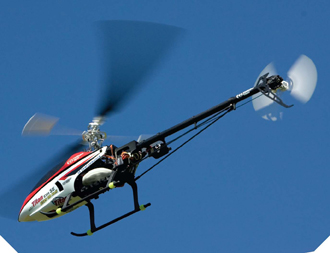Micro RC helicopters are fascinating. For many, they are the ultimate flying machines. To master a miniature helicopter so you can fly it in your living room or from your back porch and turn your picnic table into a heli pad is amazingly satisfying. Micro helis are great for someone wanting to learn to fly helicopters without a big cash investment and they’re perfect for accomplished heli flyers looking for something less complicated and less expensive to fly indoors. Here are our answers to some common questions we’ve gotten from our readers.
Q: WHAT’S THE BEST TYPE HELICOPTER TO FLY?
ANSWER: The heli type you choose will depend on how much you want to spend and what level of performance you’re interested in. If you just want to hover around in your living room or occasionally patrol the back porch on a calm afternoon, a co-axial or fixed-pitch heli is your best choice. If, however, you have the piloting skills and want all-out aerobatic performance, then a collective-pitch heli will keep you interested for a long time.
Q: WHAT ARE THE DIFFERENCES BETWEEN CO-AXIAL AND FIXED-PITCH HELIS?
ANSWER: The most popular choice for modelers very new to the hobby is the co-axial type. These have two counter-rotating rotor blades spinning on the main shaft and no tail rotor. They’re very stable, which makes them easy to learn with and most come ready-to-fly and include everything you need like the radio system, battery pack and charger.
With fixed pitch helis, there’s only one set of blades and the angles of the blades are fixed and cannot be adjustable. Both types actually have fixed-pitch rotor blades so increasing or decreasing the speed of the main rotor controls the altitude for both types. Fixed-pitch helis have a driven tail rotor to control yaw.

Yes, indeed, once you master hovering your micro heli, you’ll feel like Superman! Practice makes perfect.
Q: ARE FLIGHT SIMULATORS WORTH THE MONEY TO LEARN HOW TO FLY HELICOPTERS?
ANSWER: Yes, absolutely! Flight sims will greatly speed up the learning curve and make learning to hover with a real heli much easier. Of course, there’s no substitute for an experienced, real-life heli pilot helping you master the basics; a combination of both methods all but guarantees success!
Q: I’VE BEEN TRYING TO FLY FURTHER AWAY FROM MYSELF IN LARGE CIRCLES. I SOMETIMES LOSE CONTROL AND END UP LANDING HARD WITH LESS THAN ACCEPTABLE RESULTS. IS THERE A TRICK TO KEEPING TRACK OF MY MODEL FAR AWAY?
ANSWER: It’s inevitable that you’ll lose orientation while expanding your flight area. To prevent situations where you lose control, be sure to really master the basics of hovering. This includes hovering nose-in and tail-in while facing either the left and right side of your model. Often, new pilots get really good at hovering in a particular situation, such as with the heli positioned forward and to the right with its nose pointing slightly to the left. Before you venture deeply into forward flight, make sure you can hover comfortably at all orientations and with your heli’s nose pointing in all directions.

As you expand your flying area, you need to also constantly work on hovering your heli from all different angles and attitudes. It’s easy to get disoriented when your helicopter moves to an unusual position-like this Thunder Tiger Titan SE has; your ability to keep your orientation is key to maintaining control.
ANSWER: Regardless of the type of heli you fly, some fine-tuning must be done to have stable flight. With fixed-pitch helis, the tail rotor provides left/right yaw control and the onboard electronics control both the main rotor and tail rotor motors. With co-axial helis, the electronics control the two motors that spin the two sets of main rotor blades and the left/right yaw function is done by varying the speed between the two rotor blade sets. With some models, a gyro function is integrated in the receiver to keep the model tracking straight. Depending on your heli’s setup, increasing or decreasing the gyro gain will help solve slight nose-turning issues.

Micro indoor helis are a lot of fun. Many are stable enough to land in your hand.
Q: I’VE BEEN FLYING A FIXED-PITCH HELI FOR A WHILE AND NOW I WANT TO GET INTO AEROBATICS. HOW DOES A COLLECTIVE PITCH ROTOR HEAD WORK?
ANSWER: With a collective-pitch heli, you vary its altitude by increasing or decreasing the angle of the main rotor blades. This is the main feature that gives a helicopter quicker response and allows it to perform aerobatics including flying upside down. These are the most complicated types of helicopter and require collective-pitch and throttle settings to be mixed together. A helicopter-specific radio is required to properly control them.
Q: I JUST GOT A SMALL INDOOR HELICOPTER AND WANT TO FLY IT IN MY ROOM. WHAT CAN I DO TO IMPROVE MY SKILLS?
ANSWER: First, don’t try to learn in your bedroom. With a bed and dresser in the way, there just isn’t enough space. Use a large living room or a family room area with the furniture moved out of the way. A smooth, hard floor is better than carpeting, as it allows the heli to slide around and helps prevent it from tipping over. If it does tip over, chop the throttle. Use training gear if they are available for your model. Apply power smoothly and slowly. Jamming on the power will cause the tail to spin around.
Start hovering with short hops while trying to keep the nose pointed in the same direction. If you get confused, throttle down slowly so the model doesn’t just fall out of the air. Master one control at a time and then concentrate on the next. Trying to master everything all at once, left, right, up, down, yaw left or right, will get very confusing. Finally, don’t over control. Let your heli’s builtin stability do the work before adding in a command.
























Great post. i loved it all. I myself have a love affair with RC Helicopters, i have several. infact that is how my love of copters began, only recently have i also started taking to the air myself (http://www.flyhaa.com/en/page/helicopter_flight_training_courses) now i get to fly from the air and the ground, thanks for the post.